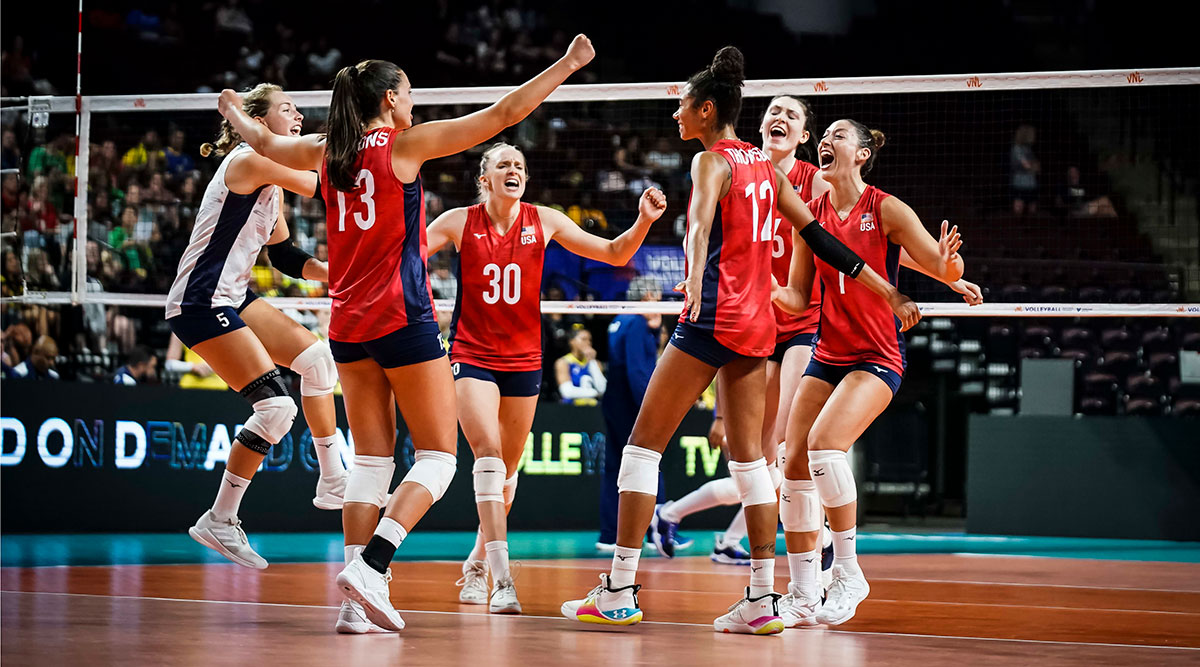History and Evolution of US Women’s Volleyball: Us Womens Volleyball

The history of women’s volleyball in the United States is a captivating tale of innovation, growth, and the unwavering spirit of female athletes. From its humble beginnings as a recreational activity to its current status as a globally recognized sport, women’s volleyball has come a long way, leaving an indelible mark on the sporting landscape.
Early Days and the Rise of Indoor Volleyball
Women’s volleyball in the United States originated in the late 19th century as a physical education activity. William G. Morgan, a physical director at the YMCA in Holyoke, Massachusetts, invented the game in 1895, calling it “mintonette.” The game was initially designed to be a less strenuous alternative to basketball, with a focus on agility and teamwork. Mintonette quickly gained popularity among women, and by the early 1900s, it was being played in schools, colleges, and community centers across the country.
The transition from outdoor to indoor volleyball was a significant milestone in the evolution of the sport. The early versions of volleyball were played outdoors, often on grass or dirt courts. However, the development of indoor courts in the 1920s and 1930s provided a more controlled and consistent environment for the game. This shift also led to the standardization of rules and equipment, paving the way for the development of organized leagues and tournaments.
The Rise of the NCAA and the Development of Collegiate Volleyball
The establishment of the National Collegiate Athletic Association (NCAA) in 1906 marked a turning point for women’s volleyball. The NCAA provided a framework for organizing and governing collegiate athletics, including volleyball. The NCAA Women’s Volleyball Championship was first held in 1981, and since then, it has become one of the most prestigious events in women’s collegiate sports.
The growth of collegiate volleyball in the United States has been fueled by the dedication of coaches, players, and administrators. The NCAA has provided opportunities for female athletes to compete at the highest levels of the sport, fostering a culture of excellence and athleticism. Over the years, numerous universities have established strong volleyball programs, producing talented players who have gone on to compete professionally and internationally.
The Establishment of Professional Leagues
The professionalization of women’s volleyball in the United States began in the 1970s, with the emergence of the first professional leagues. The American Volleyball Association (AVA) was founded in 1974, and it quickly gained popularity among fans and players alike. The AVA featured teams from across the country, and its matches were broadcast on television, helping to raise the profile of the sport.
The establishment of the Women’s Professional Volleyball League (WPVL) in 1978 marked another significant milestone. The WPVL was a more structured and competitive league, with a focus on attracting top-level talent. The WPVL’s success helped to pave the way for the development of other professional leagues, including the current professional volleyball league in the United States, the AVP Pro Beach Volleyball Tour.
Key Figures and Teams, Us womens volleyball
The history of US women’s volleyball is filled with inspiring figures who have made significant contributions to the sport. One of the most influential figures is Karch Kiraly, a three-time Olympic gold medalist and former head coach of the US women’s national team. Kiraly’s achievements as a player and coach have inspired generations of female volleyball players.
Another notable figure is Misty May-Treanor, a three-time Olympic gold medalist in beach volleyball. May-Treanor’s dominance in beach volleyball helped to popularize the sport in the United States and around the world. Her athleticism, skill, and sportsmanship have made her a role model for aspiring athletes.
Several teams have played a pivotal role in the growth of US women’s volleyball. The University of Southern California (USC) women’s volleyball team has won numerous NCAA championships and produced a number of talented players. The Stanford University women’s volleyball team has also been a powerhouse in collegiate volleyball, winning multiple NCAA titles.
The US women’s national team has been consistently ranked among the top teams in the world. The team has won multiple Olympic medals, including gold in 1984, 2008, and 2012. The success of the US women’s national team has helped to raise the profile of volleyball in the United States and inspire a new generation of players.
Us womens volleyball – The US women’s volleyball team, a force of athleticism and precision, moves with the grace of a tropical breeze, each spike a testament to their dedication. Perhaps after a hard-fought victory, they savor the sweet, coconut-kissed notes of blue chair bay coconut spiced rum , a reminder of the sun-drenched beaches that fuel their dreams.
The taste, like their victories, is a celebration of power and passion, a testament to their enduring spirit.
The US Women’s Volleyball team, with its synchronized movements and explosive power, is a sight to behold. Their athleticism is a testament to years of rigorous training, much like the delicate balance required to lift a heavy blue chair, a feat outlined in the comprehensive guide how to pick up a blue chair.
Just as the team relies on each player’s strength and coordination, so too does lifting a chair require proper technique and understanding of weight distribution. The US Women’s Volleyball team, however, is not lifting chairs, but smashing volleyballs, a sport that requires a different kind of strength and finesse.
